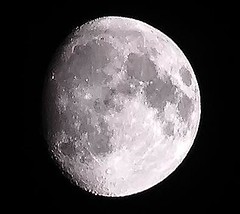HomerSimpson
TPF Noob!
- Joined
- Nov 25, 2007
- Messages
- 32
- Reaction score
- 0
- Can others edit my Photos
- Photos OK to edit
Do most of you go out with the intent to photograph certain objects or do you just get the camera out when you see something you think might look good? I'm more of the second one, I take my digicam everywhere with me and when I find something I like, I take a snap of it and if it looks good enough, I might be convinced to take the SLR and snap away with that.
Also, I don't know if it's only me who gets this but sometimes I see something that looks great to the human eye but when I photograph it, it comes out looking crappy, for example the moon. There is a tree outside my house and whenever the moon comes up it is always behind the tree and in the winter time it makes a great visual but whenever I photograph it, it never comes out properly, my camera won't pick up the detail, is there any way I can overcome that? A few weeks ago the moon was out behind some clouds and it looked excellent but when I took the picture, it just looked like a blob, how can I overcome that? I couldn't really use a tripod because I was hanging halfway out of my bedroom window.
This has turned into a more moon related question (this is the last one, I promise!) A few night ago the moon was right outside my bedroom window and it cast a shadow on my curtains and I wanted to take a picture of it but I couldn't capture it, with the flash off you saw all black, with the flash on all you saw was the curtain, how do you get that middle ground? I could see clearly what I wanted to snap but my camera wouldn't pick it up :sad anim:. What do you do in that situation? Admit defeat? I could have turned the ISO up I suppose but that never came to me at that time, also, wouldn't that have made it super grainy anyway? Thus getting rid of the clean lines of the shadow I got?
Anywho, more questions..
How do you decide what is a good picture? That has always stumped me Most of the time I just hit and hope.
Most of the time I just hit and hope.
Where do you put your point of focus? This is hard for me because I don't really focus in on one particular thing because I feel that if I do, I will get a crappy photo.
Anywho, any advice you have which I haven't asked for is appreciated
Thanks
Also, I don't know if it's only me who gets this but sometimes I see something that looks great to the human eye but when I photograph it, it comes out looking crappy, for example the moon. There is a tree outside my house and whenever the moon comes up it is always behind the tree and in the winter time it makes a great visual but whenever I photograph it, it never comes out properly, my camera won't pick up the detail, is there any way I can overcome that? A few weeks ago the moon was out behind some clouds and it looked excellent but when I took the picture, it just looked like a blob, how can I overcome that? I couldn't really use a tripod because I was hanging halfway out of my bedroom window.
This has turned into a more moon related question (this is the last one, I promise!) A few night ago the moon was right outside my bedroom window and it cast a shadow on my curtains and I wanted to take a picture of it but I couldn't capture it, with the flash off you saw all black, with the flash on all you saw was the curtain, how do you get that middle ground? I could see clearly what I wanted to snap but my camera wouldn't pick it up :sad anim:. What do you do in that situation? Admit defeat? I could have turned the ISO up I suppose but that never came to me at that time, also, wouldn't that have made it super grainy anyway? Thus getting rid of the clean lines of the shadow I got?
Anywho, more questions..
How do you decide what is a good picture? That has always stumped me
Where do you put your point of focus? This is hard for me because I don't really focus in on one particular thing because I feel that if I do, I will get a crappy photo.
Anywho, any advice you have which I haven't asked for is appreciated
Thanks


 @Cleavage.
@Cleavage.

![[No title]](/data/xfmg/thumbnail/34/34139-e52deba745f42ba091907fcc460cd6db.jpg?1734164696)








